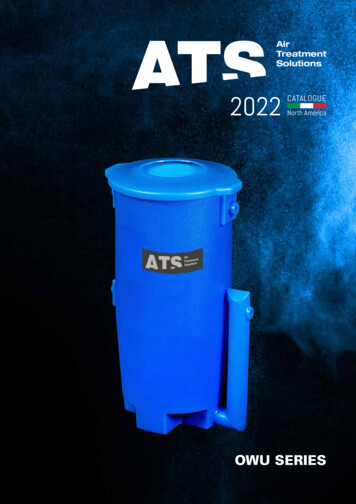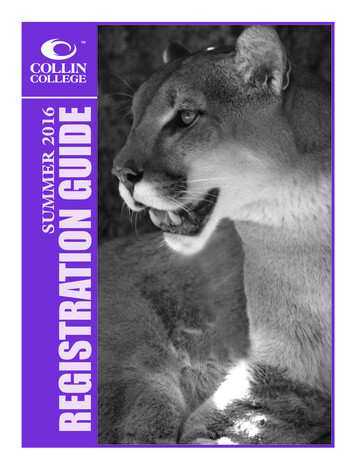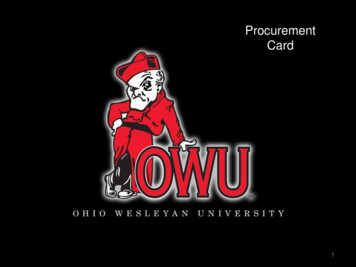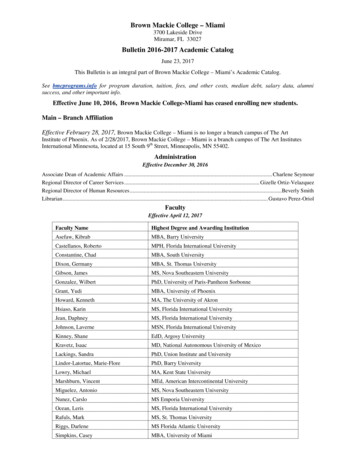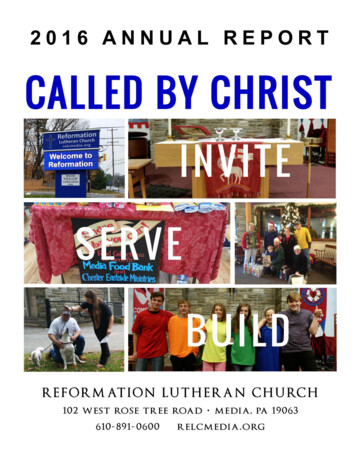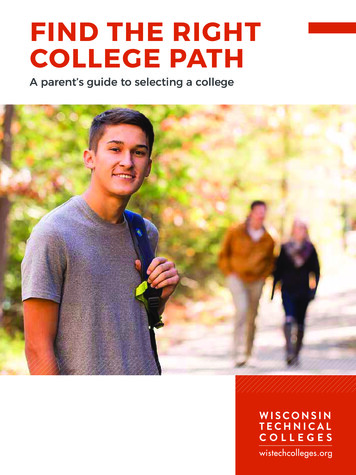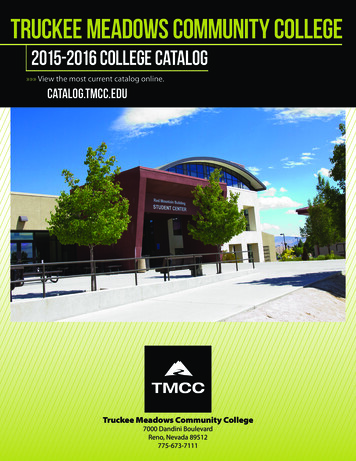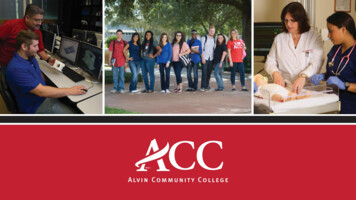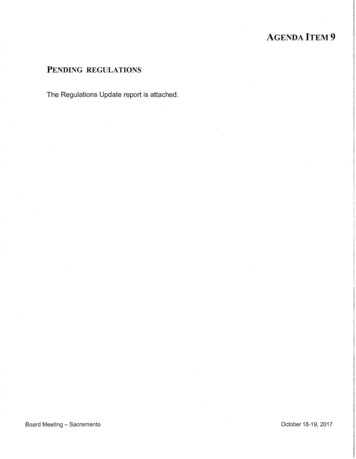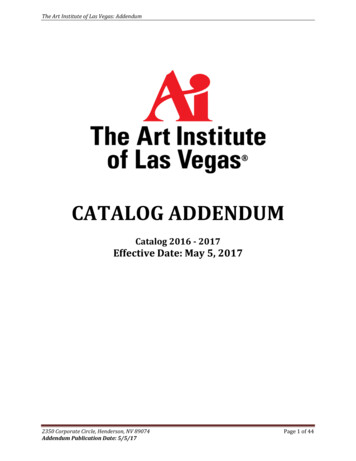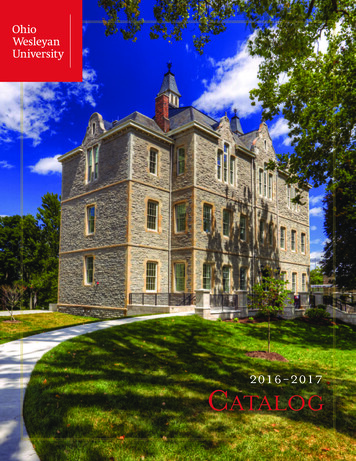
Transcription
2016-2017CATALOG
Correspondence DirectoryCorrespondence should be addressed to: Ohio Wesleyan University, 61 South Sandusky Street, Delaware, Ohio 43015. The University’s general telephonenumber is (740) 368-2000 and the University’s website is located at https://owu.edu. When dialing from off campus, use “368” (preceded with area code“740,” if required) and the extension for the offices and individuals listed below. A complete directory of University offices and employees is available onlineat https://owu.edu/directory.ACADEMIC CONCERNSDr. Lynda Hall, Associate Dean(Extension 3810, lkhall@owu.edu)ADMISSION AND FINANCIAL AIDMs. Susan Dileno, Vice President for Enrollment(Extension 3025, srdileno@owu.edu)ATHLETICSMr. Roger Ingles, Director of Athletics(Extension 3738, rdingles@owu.edu)CAREER SERVICESMs. Leslie Melton, Director of Career Services(Extension 3152, ljdelerm@owu.edu)CHAPLAINThe Rev. Jon Powers(Extension 3082, jrpowers@owu.edu)COUNSELINGDr. Doug Bennett(Extension 3145, dlbennet@owu.edu)DEPOSITS, FEES, AND CHARGESMs. Jeanne Farnlacher, Bursar(Extension 3362, jkfarnla@owu.edu)GIFTSMs. Colleen Garland, Vice President for University Advancement(Extension 3015, ccgarlan@owu.edu)HONORS PROGRAMDr. Amy McClure, Coordinator (Extension 3562, honors@owu.edu)HOUSINGMs. Wendy Piper, Assistant Dean of Student Affairs/Director of Residential Life(Extension 3175, wlpiper@owu.edu)INTERNATIONAL AND OFF-CAMPUS PROGRAMSMr. Darrell Albon, Director of International and Off-Campus Programs(Extension 3070, iocp@owu.edu)MULTICULTURAL STUDENT AFFAIRSMs. Terree Stevenson, Director(Extension 3151, tlsteven@owu.edu)REGISTRATION, RE-ADMISSION, AND TRANSCRIPTSMs. Shelly McMahon, Registrar(Extension 3200, registrar@owu.edu)STUDENT ENGAGEMENT AND SUCCESSDr. Dwayne Todd, Vice President for Student Engagement and Success(Extension 3135, dktodd@owu.edu)STUDENT HEALTH CENTERMs. Marsha Tilden, Director(Extension 3163, matilden@owu.edu)SUMMER PROGRAMSDr. Dale Swartzentruber, Associate Provost(Extension 3811, deswartz@owu.edu)UNIVERSITY COMMUNICATIONSMr. Will Kopp, Chief Communications Officer(Extension 3108, wekopp@owu.edu)
2016-2017 CatalogOhio Wesleyan UniversityContentsContentsCalendar. inside back coverThe UniversityIntroduction. 1Statement of Aims. 3Intellectual Freedom and Responsibility. 4Statement on Student Rights. 5University Diversity Efforts. 6Traditions. 6Academic Regulations and ProceduresAcademic Advising. 8Admission. 8Advanced Placement. 9International Baccalaureate. 11Examinations for Placement and/or Credit. 12Registration in Courses. 13Reports and Grades. 16Residence Requirement. 19Academic Probation and Dismissal. 19Academic Honesty. 20Academic Grievance Policy. 23Responsibility for Meeting Requirements. 25Final Examination Policy. 25Leave of Absence. 26Withdrawal from the University. 26Reinstatement. 26Classification of Students. 27Transfer of Credits. 27Student-Initiated Courses. 27Petitions. 28Academic Honors and DistinctionsAcademic Honors. 29Honorary Societies. 32i
2016-2017 CatalogOhio Wesleyan UniversityContentsDegrees and Special ProgramsRequirements for All Degrees. 33The Bachelor of Arts Degree. 36The Bachelor of Fine Arts Degree. 39The Bachelor of Music Degree. 40Two Bachelor’s Degrees. 40Combined Bachelor’s / Professional Degrees. 40Other Pre-Professional Programs. 41Other Interdepartmental Majors. 41Self-Designed Majors. 42The OWU Connection. 43Sagan National Colloquium. 45Cross-Cultural Experience. 45Off-Campus Study Programs. 45International Programs. 46Domestic Programs. 49Apprenticeships and Internships. 50Special Language Program. 51Summer School. 51Majors and Courses of InstructionKey to Abbreviations. 52Course Selection. 52Majors and Minors. 53Courses of Instruction. 146Student Affairs and Non-Academic RegulationsStudent Affairs and Non-Academic Regulations. 245Student Affairs. 245The Student Handbook. 245Expenses and Financial AidTuition and Fees. 246Financial Aid. 246Fees. 247Payment Methods. 251Withdrawals and Refunds. 252FacilitiesLibraries. 253University Housing. 254Instructional and Administrative Buildings. 256University Offices. 259Student Offices. 260ii
2016-2017 CatalogOhio Wesleyan UniversityContentsThe Corporation (Board of Trustees)Officers of the Board. 268University PersonnelOffice of the President. 270Office of Enrollment Management. 270Office of University Communications. 271Office of the Provost. 271Student Engagement and Success. 272Office of University Advancement. 273Office of Finance and Administration. 275Perkins Observatory. 275Adjunct Faculty. 275New York Arts Program. 276Faculty and Staff Emeriti. 276Department Chairpersons 2016-2017. 278Program Directors. 279University Libraries. 279Faculty of Instruction. 280Index. 287iii
The UniversityIntroductionIntroductionOhio Wesleyan University is an independent, undergraduate liberal arts institution enrollingabout 1,675 students, almost equally men and women, from nearly all 50 states and more than30 countries. The multicultural enrollment total of approximately 27 percent includes both U.S.multicultural students and international students; the University is strongly committed to racial,ethnic, and cultural diversity. In 2015, the average OWU student ranked in the top 28% of his orher high school class.Outstanding teaching is a hallmark of the University, which is best known for the quality andaccessibility of its faculty. Ohio Wesleyan has 146 full-time faculty positions, of which nearly40 percent are female. One hundred percent of full-time tenure-track faculty holds a Ph.D. orequivalent, or is completing work toward the degree.The University confers the Bachelor of Arts, Bachelor of Fine Arts, and Bachelor of Music; andoffers combined-degree (3-2) programs in engineering, interdisciplinary and applied science,medical technology, optometry, and physical therapy. Degrees are offered through 24 academicdepartments and several interdisciplinary programs. Distinctive features of the academic programinclude the Arneson Institute for Practical Politics and Public Affairs; The Woltemade Center forEconomics, Business and Entrepreneurship and its Economics Management Fellows Program; theSagan National Colloquium; a four-year Honors Program; a Student Symposium, the SummerScience Research Program and its associated Patricia Belt Conrades Summer Science ResearchSymposium; and extensive opportunities for independent research, internships, and off-campusstudy. Especially noteworthy is the University’s unique Theory-to-Practice Grant program, whichallows students and faculty to compete for grants for extensive research projects, usually conductedoutside the United States. These grants may be awarded to individual students or to small groupsof students working with one or more faculty members. Other travel-learning opportunities areabundant.Ohio Wesleyan is accredited by The Higher Learning Commission and is a member of the NorthCentral Association of Colleges and Schools, 230 North LaSalle Street, Suite 7-500, Chicago,Illinois 60604-1411 (Phone: 312-263-0456, http://www.hlcommission.org/). The Universityalso is approved by the American Association of University Women and is a member of theAssociation of American Colleges and the University Senate of the United Methodist Church.Appropriate departments are approved or accredited by the American Chemical Society Committeeon Professional Training, the National Association of Schools of Music, the Ohio Department ofEducation (for licensure of elementary and secondary school teachers), and the National Councilfor Accreditation of Teacher Education (NCATE). The University is a member of the Great LakesColleges Association, Inc., a nonprofit corporation of 13 leading independent institutions inIndiana, Michigan, Pennsylvania, and Ohio.Founded by Methodists in 1842, Ohio Wesleyan maintains an active affiliation with The UnitedMethodist Church, but welcomes students of all religious faiths. The University Chaplain providessupport for all denominations and coordinates an active program of social action and communityservice. Known early in its history as the “West Point of Missions” because of the number ofgraduates who served abroad as missionaries, Ohio Wesleyan later was recognized for the numberof alumni who served as Peace Corps volunteers. Today, that same commitment to serving societymanifests itself in the activities of Ohio Wesleyan students, an extraordinary percentage of whomparticipate in volunteering and philanthropic initiatives. For the sixth consecutive year, OhioWesleyan University students are being recognized for their service to others with inclusion on the2014 President’s Higher Education Community Service Honor Roll.1
The UniversityIntroductionFor nearly 175 years, the quality of an Ohio Wesleyan education has been reflected in theUniversity’s alumni. Charles Warren Fairbanks, Class of 1872, served as vice president of the UnitedStates under Teddy Roosevelt. Branch Rickey, Class of 1904, was named ESPN’s most influentialsports figure of the 20th century, for breaking the color barrier in professional baseball by signingJackie Robinson to the Brooklyn Dodgers. Clergyman Norman Vincent Peale ’20 inspired millionswith his book The Power of Positive Thinking. Ohio Wesleyan boasts two Nobel Prize winners: thelate Sherwood Rowland ’48 won the prize in chemistry in 1995, and Woodrow Clark ’67 sharedthe 2007 Nobel Peace Prize with Al Gore as a member of the Intergovernmental Panel on ClimateChange.Other notable alumni include: Robert E. Lee ’39, playwright, Inherit the Wind Jean Carper ’53, best-selling author and columnist Melvin Van Peebles ’53, multiple Tony-nominated writer, actor, and filmmaker David H. Smith, M.D. ’53, inventor of the Haemophilus influenzae type b (HiB) vaccine Phillip Meek ’59, Senior VP and President, publishing group, Capital Cities/ABC (retired) George Conrades ’61, Chairman, Akamai Technologies Paul Schimmel, Ph.D., ’62, Ernst & Jean Hahn Professor of Molecular Biology, Schimmel-YangLaboratory, Scripps Research Institute William Batchelder ’64, Speaker of the House, Ohio House of Representatives (retired) Edward D. Miller, M.D., ’64, CEO and Dean of the Medical Faculty, Johns Hopkins School ofMedicine (retired) Richard North Patterson ’68, multiple best-selling author JoAnn Verburg ’72, internationally known photographer Greg Moore ’76, Editor, The Denver Post (retired) Susan Headden ’77, Pulitzer Prize-winning journalist Tom Jolly ’77, Associate Masthead Editor, The New York Times Bob DiBiasio ’77, Senior Vice President of Public Affairs, the Cleveland Indians Byron Pitts ’82, “Nightline” Anchor, Emmy Award-winning broadcast journalist. Jeff Long ’82, Vice Chancellor and Director of Athletics, University of ArkansasAnd many more leaders in medicine, business, education, athletics, industry, government, law, arts,and nonprofit organizations.An exciting sense of energy at Ohio Wesleyan is based largely on a new curricular plan that offersa series of connected courses allowing students to study a topic by taking courses from a variety ofdisciplines over a protracted period of time, a growing number of Travel-Learning Courses that givestudents an up-close look at issues they have discussed in class, and an expanded Theory-to-PracticeGrant program in which students design their own research, internship, service, and culturalimmersion grant requests and then carry out their projects in locations throughout the world.2
The UniversityIntroductionStatement of AimsIn addition, the University has embarked upon an ambitious donor-funded campus renewalprogram, including a 14 million renovation of Stuyvesant Hall, 8 million renovation of MerrickHall to create the Home of The OWU Connection, and 10 million renovation of EdwardsGymnasium, which also created the state-of-the-art Simpson Querrey Fitness Center and JannuziDance Studio. In 2015, the University began building a new donor-funded Small Living Unit(SLU) complex, which opens in fall 2016. Construction on a second donor-funded SLU began inMay 2016, with completion expected in time for spring semester 2017.The JAYwalk, which is the thoroughfare between the academic and residential sides of campus, hasbeen lengthened and upgraded, most recently with a fountain, open lawn, and garden that bringsthe feel of a European plaza to the middle of campus and with additional green and garden space.OWU continues to be recognized by U.S. News and World Report as being among the nation’stop liberal arts colleges. Ohio Wesleyan also holds its place in The Templeton Guide: Colleges thatEncourage Character Development and in its guidebook. Ohio Wesleyan currently is listed in ThePrinceton Review Guide to the Best 379 Colleges, The Fiske Guide to Colleges 2016, and the latestedition of Colleges That Change Lives. Washington Monthly has named the University among thenation’s top 45 liberal arts institutions based upon OWU’s performance as an engine of socialmobility, its contribution to fostering scientific and humanistic research, and its promotion ofan ethic of community service. Newsweek has called Ohio Wesleyan one of the nation’s top 25service-minded schools, and The Princeton Review has cited OWU students as among the nation’s“happiest.”Statement of AimsSince its founding, Ohio Wesleyan has maintained its connection with the Methodist (now UnitedMethodist) Church, offering a quality of scholarship, leadership, and service that has enrichedboth Church and society. Its charter provided that “the University is forever to be conducted onthe most liberal principles, accessible to all religious denominations, and designed for the benefitof our citizens in general.” In the spirit of this heritage, the University defines itself as a communityof teachers and students devoted to the free pursuit of truth. Ohio Wesleyan attempts to developin its students qualities of intellect and character that will be useful no matter what they choose todo in later life. The transmission, extension, and discovery of knowledge are central to the liberalarts tradition. While encouraging professional scholarship and feeling justifiably proud of its facultyand graduates who enjoy national or international reputations in their fields, the University hasas its preeminent purpose to be a quality institution for teaching and learning. Because effectiveteaching is of the highest importance, members of the faculty regularly are reviewed and evaluatedfor excellence in teaching.Ohio Wesleyan judges itself successful when it has accomplished three objectives in its work withstudents:The first is to impart knowledge. Included here is knowledge about our cultural past; a liberaleducation communicates what great minds have thought, great artists have created, and greatleaders have done. Also included is new knowledge; a liberal education communicates what is beingacquired on the frontiers of contemporary inquiry and current advances of the human spirit. Theobjective of imparting knowledge begins with the conviction that it is intrinsically worthwhile topossess the knowledge and insight transmitted through the humanities, arts, and sciences.3
The UniversityStatement of AimsIntellectual Freedom and ResponsibilityA second major objective is to develop and enhance certain important capabilities of students.As they progress through the curriculum of the University, students secure the foundational skillsof reading, writing, and quantitative analysis. They build on these skills the capacity to thinkcritically and logically, to employ the methods of the different fields of inquiry, and to understandthe symbolic languages used to codify and communicate knowledge in today’s society. They maydevelop aesthetic sensibilities or creative talents in several fields. Many students learn to integratetheory with practice by preparing for careers within various disciplines and through pre-professionaland professional programs.The third objective is to place education in the context of values. A liberal education seeks todevelop in students understanding of themselves, appreciation of others, and willingness to meetthe responsibilities of citizenship in a free society. It recognizes that trained sensitivity to privateand public value issues, grounded in a sound grasp of various cultural heritages, is important formaturation and for living a good life. It accords high honor to intellectual honesty. Consistent withour Methodist tradition, Ohio Wesleyan encourages concern for all religious and ethical issues andstimulates its students to examine their own views in light of these issues.To the extent that Ohio Wesleyan educates liberally, it fulfills its ultimate purpose of equippingstudents with knowledge, competence, and character for leadership, service, and continued learningin a complex and increasingly global society.IntellectualFreedom andResponsibilityA Joint Statement by the Trustees and Faculty Members of Ohio Wesleyan UniversityThe Charter of Ohio Wesleyan University, granted in 1842, provides that “the University isforever to be conducted on the most liberal principles, accessible to all religious denominations,and designed for the benefit of our citizens in general.” The spirit of this statement has persistedthrough the years, so that today Ohio Wesleyan continues to live and thrive in an environment ofintellectual freedom. It is, therefore, fully committed to a more recent declaration of the GeneralConference of the Methodist Church (1952):“Our role is not to suppress ideas, but to open channels of communication,so that [men and women] can come to know the thoughts of their neighbors,and so that the best thoughts of all (men and women) can come to be thepossessions of all humanity.”In pursuit of this tradition, the administration has maintained for students and faculty alike aclimate of freedom in learning and inquiry. As a specific guarantee of this climate of intellectualfreedom, the faculty and the Board of Trustees have adopted the 1940 statement of the AmericanAssociation of University Professors relative to academic freedom. It states: “The teacher isentitled to freedom in the classroom in discussing (his/her) subject, but should be careful not tointroduce.controversial matter which has no relation to (the) subject.” The only limitation thatcan appropriately be placed upon the teacher’s academic activities are those required by the acceptedstandards of (his or her) professions, such as sustained inquiry, propriety of statement, integrity ofcharacter, and objectivity of exposition.4
The UniversityIntellectual Freedom and ResponsibilityStatement on Student RightsOhio Wesleyan has recognized that its faculty and students are citizens of local, state, and nationalcommunities, as well as members of an academic community. The 1940 statement of the AmericanAssociation of University Professors emphasizes the freedom and responsibility of teachers as citizensin the following words: “When (the teacher) speaks or writes as a citizen (he/she) should be freefrom institutional censorship or discipline, but (his/her) special position in the community imposesspecial obligations. As a (person) of learning and an educational officer (he/she) should rememberthat the public may judge (his/her) profession and institution by (his/her) utterances. Hence (he/she) should at all times be accurate, should exercise appropriate restraint, should show respect forthe opinions of others, and should make every effort to indicate that (he/she) is not an institutional(spokesperson).” Within these appropriate limits, faculty members should be free to think and act ascitizens of the whole community.Equivalent importance is placed upon academic freedom and responsibility for students at OhioWesleyan, as expressed by the faculty and Board of Trustees in their adoption of the following 1965statement by the American Association of University Professors:“Free inquiry and free expression are essential attributes of the community of scholars. As membersof the community, students should be encouraged to develop the capacity for critical judgmentand to engage in a sustained and independent search for truth. The freedom to learn dependsupon appropriate opportunities and conditions in the classroom, on the campus, and in the largercommunity. The responsibility to secure and to respect general conditions conducive to the freedomto learn is shared by all members of the academic community. Students should endeavor to exercisetheir freedom with maturity and responsibility.”Statement onStudent RightsIn 1970, the Ohio Wesleyan faculty adopted the Joint Statement on Rights and Freedoms ofStudents, which endorses a concept of community responsibility where students, along withfaculty and administrators, are encouraged to play a more determining role in the formulation ofinstitutional policy.5
The UniversityUniversity Diversity EffortsTraditionsUniversity DiversityEffortsA Summaryof the PlanAn essential function of a university is to help all persons realize their potential. To this end, OhioWesleyan University affirms its support of equal opportunity for and nondiscrimination against allqualified persons regardless of race, color, creed, national origin, sex, disability, sexual orientation,age, religion, or family relationship. Furthermore, Ohio Wesleyan University asserts that diversitywill be pursued to provide access to employment, benefits, programs, education, and facilities toqualified individuals.Ohio Wesleyan University believes that minimum or least-effort actions and procedures areineffective in assuring equal employment and diversity. Simple abstention from overt discriminationor the rewriting of the job descriptions and criteria for employment will not fulfill moralobligations. Culturally biased preferences for one sex over another or one race over another are notvalid reasons for exclusionary practices or unjust criteria for employment.Since the elimination of any discriminatory practices, intentional or
(SLU) complex, which opens in fall 2016. Construction on a second donor-funded SLU began in May 2016, with completion expected in time for spring semester 2017. The JAYwalk, which is the thoroughfare between the academic and residential sides of campus, has
